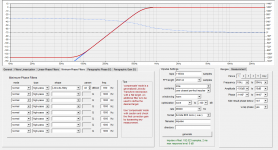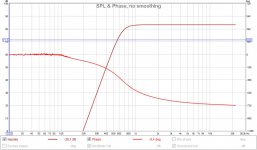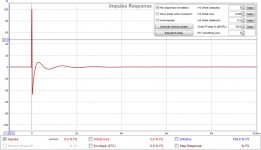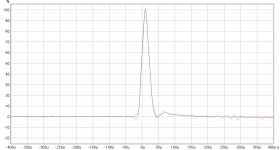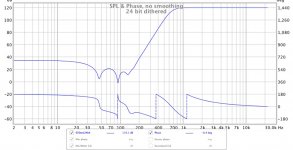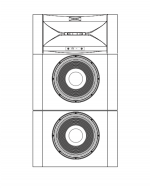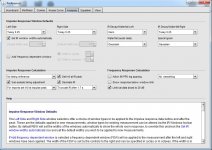Impulse offset is about 1ms in rephase, but impulse peak is a 0 when importing to REW. Strange.
Level gets at 80dB in REW, but 0dB in rephase. Strange.
Level gets at 80dB in REW, but 0dB in rephase. Strange.
Last edited:
If you set "hiding phase result below" to -Inf in rephase you will probably see a red phase curve that matches the one you see in REW.
Now change export format from 24bit to 32bit and you might get a better result.
You can also try to increase the impulse centering value to take FFT errors into account.
Now change export format from 24bit to 32bit and you might get a better result.
You can also try to increase the impulse centering value to take FFT errors into account.
You are only getting issues at -140dB or so, even with a pretty good soundcard the noise floor will be at -110 to -100dB so this is 30 to 40dB below the electronic noise floor let alone the acoustic one in your room.
I tested the same filter and got the same response with taps from 16000 up to 131000.
I tested the same filter and got the same response with taps from 16000 up to 131000.
Ok, I see.
My expectaton was to get a reference curve for spl and phase. But the steepnes of the filter makes the level go down too low then.
64-bit file maybe had made it.
My expectaton was to get a reference curve for spl and phase. But the steepnes of the filter makes the level go down too low then.
64-bit file maybe had made it.
Still strange phase.
I also tried "middle", even more strange phase.
REW says "16bit" in the bottom. I do not have my usb-soundcard attached. Is REW the problem now?
Set "hide phase" to -inf and not +inf in rephase and you will see the same phase behavior as what REW shows.
I am using REW 5.18 and rePhase 1.2.0.
What are holding you back when REW is freeware and latest beta is real magic 😀 and you will probably need it anyway for your phase-two "average room correction" (Changelist: REW Beta Release - Changes in V5.19 beta 7 | AV NIRVANA)
Take it or lieve it tips for your "pseudo-anechoic" active crossover correction and learning Rephase to REW:
Setup all pass bands in Rephase including planned or physical system stop bands and estimated roll off for microphone and even also maybe estimated roll off for digital domain at VHF, now include all side bands slopes into current pass band you create and what i mean here is for example tweeter shall also have high pass slopes added from the lower bands including lower stop band and it shall have low passes added from planned system stop band estimated microphone and maybe digital stopbands. Use plenty of taps (262144) and 32bit LPCM format, now over in REW use "Estimate IR Delay" for tweeter and the rest you line up having overlay window "Phase" viewable when at same for each other pass bands you add small number off sets until their phase curve they line up/overlay exactly with tweeter, now they prepared and if summed at "All SPL" tab they will be sum without any ripple and these synthetic slopes are what you shall dial in as target curve in acoustic domain and should get you closer to real world harmonizing than if you use pure textbook slopes without any other bandwidth limiting, example below synthetic target verse "pseudo-anechoic" at 96kHz.
Estimated stop band for microphone could be say in area 21-25Khz 2nd order BW, and estimated stop band for digital domain could be say for 96kHz sample rate a 16-24 order or even more LR at 48kHz.
Use always same sample rate for synthetic planning/targeting/manipulaion as measurement chain is performing at.
Attachments
Last edited:
Ok, I see.
My expectaton was to get a reference curve for spl and phase. But the steepnes of the filter makes the level go down too low then.
64-bit file maybe had made it.
If you want something that looks cleaner you can import the impulse into Audacity and export at 24 bit which will dither the file and get rid of a lot of the very low quantisation noise.
This is a 650Hz LR8 made in rephase exported at 24bit from Audacity then imported in REW
Attachments
Thanks.
I do not need a cleaner reference-curve really. I just wanted to get the transition between rePhase and REW working correctly (i.e hitting the right buttons in the right order).
I learned (I think) that REW changes T=0 to impulse peak, and changes magnitude level from 0 to 80dB, at the import of a impulse from rePhase.
I do not need a cleaner reference-curve really. I just wanted to get the transition between rePhase and REW working correctly (i.e hitting the right buttons in the right order).
I learned (I think) that REW changes T=0 to impulse peak, and changes magnitude level from 0 to 80dB, at the import of a impulse from rePhase.
What are holding you back when REW is freeware and latest beta is real magic 😀 and you will probably need it anyway for your phase-two "average room correction" (Changelist: REW Beta Release - Changes in V5.19 beta 7 | AV NIRVANA)
Take it or lieve it tips for your "pseudo-anechoic" active crossover correction and learning Rephase to REW:
Setup all pass bands in Rephase including planned or physical system stop bands and estimated roll off for microphone and even also maybe estimated roll off for digital domain at VHF, now include all side bands slopes into current pass band you create and what i mean here is for example tweeter shall also have high pass slopes added from the lower bands including lower stop band and it shall have low passes added from planned system stop band estimated microphone and maybe digital stopbands. Use plenty of taps (262144) and 32bit LPCM format, now over in REW use "Estimate IR Delay" for tweeter and the rest you line up having overlay window "Phase" viewable when at same for each other pass bands you add small number off sets until their phase curve they line up/overlay exactly with tweeter, now they prepared and if summed at "All SPL" tab they will be sum without any ripple and these synthetic slopes are what you shall dial in as target curve in acoustic domain and should get you closer to real world harmonizing than if you use pure textbook slopes without any other bandwidth limiting, example below synthetic target verse "pseudo-anechoic" at 96kHz.
Estimated stop band for microphone could be say in area 21-25Khz 2nd order BW, and estimated stop band for digital domain could be say for 96kHz sample rate a 16-24 order or even more LR at 48kHz.
Use always same sample rate for synthetic planning/targeting/manipulaion as measurement chain is performing at.
Thanks. I love the helpful mindset/culture in this thread 🙂
There are often quite some bugs corrected in every new beta-version of REW, you can see in the relase notes, historically.
I think this is a pretty advanced software, where bugs easily can happen. It would be interesting to know how much of it that has automated unit-tests.
But I will upgrade to the latest beta, just did not do it yet, the new features looks awesome.
I did not fully understand your proposed process. But I will get there 🙂 I am in learning mode. I do not know all the specific words of this context, what they mean. Stopband, and stuff like that.
I have calibrated soundcard (including my dsp) and calibrated mic (incl phase).
I will post my progress here later on, and all hints and tips are welcome.
I am building a DIY-speaker with JBL-parts, see attached pic. It will be 2.5 way for starters, with dual 15" woofers and a 4" compression-driver. Maybe I will add an UHF compression-driver later on, and make it 3.5 way.
Closed boxes for the woofers.
Attachments
Last edited:
Thanks.
I do not need a cleaner reference-curve really. I just wanted to get the transition between rePhase and REW working correctly (i.e hitting the right buttons in the right order).
I learned (I think) that REW changes T=0 to impulse peak, and changes magnitude level from 0 to 80dB, at the import of a impulse from rePhase.
Your preferences in REW determine where it aligns the IR:
As fluid showed a few posts back, you can alter this alignment.
As far as magnitude goes, the scale in RePhase has a reference level (set at 0) and can swing positive (louder) or negative (softer) from that reference level. If you import a RePhase created IR into REW and it lands at 80 dB, that's your reference level.
Impulse offset is about 1ms in rephase, but impulse peak is a 0 when importing to REW. Strange.
The impulse offset in Rephase determines where the peak will be in the created IR file from RePhase. The room before the peak is there to be able to manipulate phase. In REW, as shown on the preference page that peak is set (aligned) as t=0. Two different things we are talking about here.
Attachments
Hei, Rajapruk
If you need more inspiration for flat sub bass in one point of the room I have an example using audioweaver, stm32M4 "dsp", rew and rephase.
http://www.diyaudio.com/forums/atta...tried-eqbassboostphaseeqbrickwalllpfilter-jpg
Post 6 and 7
http://www.diyaudio.com/forums/digi...-discovery-audioweaver-tried.html#post4522868
This example is USB in only. And the simulation show that it "works" for 1 point only.
But it is possible using very cheap cortex DSP and rephase.
The phase and frequency response could be even flatter, but it would only be for showoff🙂
If you need more inspiration for flat sub bass in one point of the room I have an example using audioweaver, stm32M4 "dsp", rew and rephase.
http://www.diyaudio.com/forums/atta...tried-eqbassboostphaseeqbrickwalllpfilter-jpg
Post 6 and 7
http://www.diyaudio.com/forums/digi...-discovery-audioweaver-tried.html#post4522868
This example is USB in only. And the simulation show that it "works" for 1 point only.
But it is possible using very cheap cortex DSP and rephase.
The phase and frequency response could be even flatter, but it would only be for showoff🙂
Thank you very much wesayso, very informative for me.
The next step for me is to learn how to measure in REW, and export "correctly" to rePhase. I think I know how to do it, but I must try it: verify that T=0 is at the right place in the IR, apply smoothing and windowing if needed, and then "export measurement as text".
Then calibrations are included/applied, I hope. Pos once found, I remember, that mic-calibration is not included when IR is exported from REW.
Hei torgeirs, I do not think I will linearize phase on sub bass level. The crossover is the only thing I will try to linearize, I think, for the speaker correction. But we'll see what happens 🙂
The next step for me is to learn how to measure in REW, and export "correctly" to rePhase. I think I know how to do it, but I must try it: verify that T=0 is at the right place in the IR, apply smoothing and windowing if needed, and then "export measurement as text".
Then calibrations are included/applied, I hope. Pos once found, I remember, that mic-calibration is not included when IR is exported from REW.
Hei torgeirs, I do not think I will linearize phase on sub bass level. The crossover is the only thing I will try to linearize, I think, for the speaker correction. But we'll see what happens 🙂
Last edited:
I agree🙂
Even if it is possible.
I would read up on the grimm audio pdf
http://www.grimmaudio.com/site/assets/files/1088/speakers.pdf
I think it is relevant for your JBL application
Even if it is possible.
I would read up on the grimm audio pdf
http://www.grimmaudio.com/site/assets/files/1088/speakers.pdf
I think it is relevant for your JBL application
I have already read it. Those speakers looks to be good sounding.
They praise LR 24dB/oct, even with FIR-capability available. Got me wondering if my LR 48dB/oct is too steep.
They praise LR 24dB/oct, even with FIR-capability available. Got me wondering if my LR 48dB/oct is too steep.
I have wondered about the same. I’m using 48 dB/oct bor a system that plays very loud without horns. So I use many way and high xover freqs.
I’m concerned about displacement and distortion. But I think my ears distort more than elements when steep filter and high xover freqs are used in normal livingrooms. (at 5 meters listening distance)
Suspects a JBL horn don’t distort much at 24dB/oct and say 1,5kHz and inside 10 m.
At 30 meter (cinema back seat) its another story so then maybe the 48dB oct filters is better?
I’m concerned about displacement and distortion. But I think my ears distort more than elements when steep filter and high xover freqs are used in normal livingrooms. (at 5 meters listening distance)
Suspects a JBL horn don’t distort much at 24dB/oct and say 1,5kHz and inside 10 m.
At 30 meter (cinema back seat) its another story so then maybe the 48dB oct filters is better?
Another view is that unlinearized elements benefits from sharp filters as they don’t sum as LR theory predicts (not 0 phase difference)
When the elements are linearized in amplitude and phase before filtering, LR conditions are met, and 24 db filters sum perfect 3 octaves up and down xover frequency.
When the elements are linearized in amplitude and phase before filtering, LR conditions are met, and 24 db filters sum perfect 3 octaves up and down xover frequency.
- Home
- Design & Build
- Software Tools
- rePhase, a loudspeaker phase linearization, EQ and FIR filtering tool
